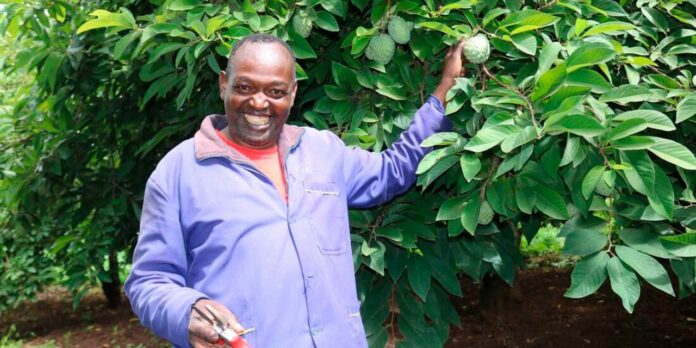Fredrick Kinyanjui is a farmer from Nyati village in Murang’a County. When he quit his truck driving job at age 22, Kinyanjui reasonably imagined that farming would make him a sustainable income.
The farmer grows Hass Avocados, Mangoes and Plaintain Bananas. The cherry on the cake is his golden venture, custard apple farming. From afar, these fruits can be confused with green apples, but with closer scrutiny, one can tell the difference.
Custard Apples are known for their rough texture, pale green colour and cone shapes. The common street name in Kenya is ‘matomoko’.
“They are custard apples (Annona reticulata). They are also known as sugar apples,” the farmer clarified.
He started growing them in 1995, however, his father has been in the business since 1970. He learnt how to grow these fruits from him.
“I have 39 Custard Apples trees that sit on on half-acre of my 5. I love fruits because I also grow avocados, bananas and mangoes, however, custard apples are my favourites,” he said in a past interview with Nation.
The fruits have provided him and his family with a steady income over the years. In a year, a single matomoko tree can produce a maximum of 700 kilos at peak maturity. This invertedly translates to an average of around 100 fruits.
Custard apple fruit prices range between Sh. 80 – Sh. 130. per kilo, translating to over Sh. 2 million for Kinyanjui annually. The 58-year-old farmer sells the custard apples to retail customers in Nairobi and even a large Supermarket.
Growing custard apples
Kinyanjui plants two varieties; the soursop and annona varieties. He explained that he plants grafted varieties of the fruit.
“I use indigenous root stock that I graft with the improved varieties. Traditional custard apple seeds have a germination rate of about 99% while the hybrid ones are below 10%,” the farmer continued.
His growing process starts by extracting seeds from ripe custard apples. He rinses the seeds and dries them under the sun for 2 days. After, he plants them in polythene bags and nurtures the seedlings, taking 10 months – 1 year.
He then grafts the seedlings with scions from his farm. Depending on a farmer’s agricultural practices, the plants can begin fruiting 6 years later.
“After transplanting, the seeds must be nurtured well with manure, fertiliser and water,” he noted, adding that good watering curbs flower abortion which is a common challenge with custard apples.
Alfred Koome: Young Meru farmer makes a six-figure income from 130 bags of potatoes, garlic
“Flowering is preceded by shedding of leaves in September but once irrigated properly or they receive good rains, the onset of flowering and fruit formation starts.”
Fredrick Kinyanjui’s peak season for the custard apples is between April and August, albeit also getting some produce in October. They thrive in areas that get an annual rainfall of above 700mm.
The fruits are considered to be rich in antioxidants. Additionally, they improve one’s immunity, promote good digestion and regulate blood pressure. When ripe, the fruits are pale green.








